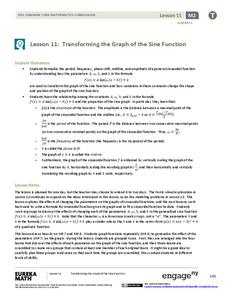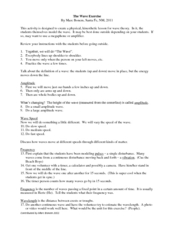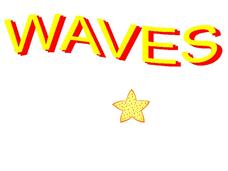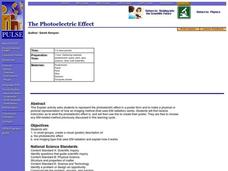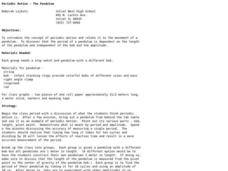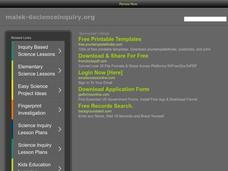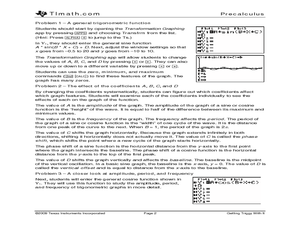EngageNY
Transforming the Graph of the Sine Function
Build a solid understanding of trigonometric transformations through exploration. Learners work in teams to analyze the effects of different algebraic components on the graph of a sine function.
It's About Time
Slinkies and Waves
Slinkies® are a great tool for visualizing waves. Pupils work in groups to create both transverse and longitudinal waves before using a polarizer to analyze the ways they are able to travel.
Virginia Department of Education
Light and the Electromagnetic Spectrum
Lead your class in a fun-filled team activity that encourages collaboration while learning important concepts. Pupils actively participate in a discussion on the experimental design and the role of mirrors. They perform group activities...
It's About Time
Making Waves
Young scientists use Slinkys to better understand waves. After creating and measuring many aspects of waves, they complete a handout and homework questions. The resource also introduces the final project for the chapter, though...
Virginia Department of Education
Sound
Add a little music to your next physics class. Pupils discuss how frequency determines pitch and take part in several activities designed to teach them more about sound, melody, resonance, and vibrations. They use materials to construct...
The Science Spot
The Wave Exercise
During a lesson on wave motion, physical science participants basically act out the waves as a group. Through their movements, the amplitude, speed, frequency, and wavelength are all identified. Ideas for modeling the reflection and...
Curated OER
Waves
An incredibly colorful PowerPoint presents all the facts and definitions about waves that you could need for beginning physical scientists. There are several useful links to online animations of wave action. This may have been produced...
Curated OER
Typical Numeric Questions for Physics I - Waves
Physics masters figure out the wavelength of different waves. Looking at a wave graph, they identify different characteristics. Many more problems get them working with both electromagnetic and sound waves. There are a total of 17...
Curated OER
Light and Elements
Here is a full-fledged investigation of light waves, the electromagnetic spectrum, and element spectra. Physicists research a scientist that contributed to our understanding of the behavior of light. They take notes on your lecture, and...
PBS
Measuring Waves | UNC-TV Science
Discover the secrets used by scientists to measure mechanical waves. Young physicists learn about measurable wave qualities—amplitude, wavelength, and frequency—by watching and listening to a video discussing longitudinal and transverse...
Mr. E. Science
Characteristics of Waves
Waves, waves, and more waves. Here, class members look at the many types and characteristics of energy waves including transverse, longitudinal, standing, seismic, p-waves, s-waves, and l-waves.
Curated OER
The Photoelectric Effect
After some online instruction, chemistry aces use their creative abilities to produce a poster describing the photoelectric effect and one type of imaging technology that uses electromagnetic radiation. This simple, straightforward...
Curated OER
Checking the Surf
Students read and discuss waves and their wavelengths and amplitudes. In this waves lesson plan, students draw the wavelength and amplitude of a wave and discuss tsunamis and storms.
Curated OER
Circular Trigonometric Functions
For this Pre-calculus/Trigonometry worksheet, students estimate the amplitude, period, and horizontal and vertical translations of a graph and find a rule that models the data. The three page worksheet contains fourteen problems. Answers...
Curated OER
Wave Properties
Use this slideshow to explain waves. Energy travelling in waves and its behavior in different materials are explained. The diagrams and equations will assist your students in defining wave type and explaining the differences...
Curated OER
Periodic Motion - The Pendulum
Learners experiment to determine the period of a pendulum. In this periodic motion instructional activity, students use different pendulums to determine their periods. They use various amplitudes to determine its effects on the period.
Curated OER
Sounds
Students explore the concept of sound. In this sound instructional activity, students explore different sounds and the objects that create them. Students will discover, through several hands-on activities, what vibration, pitch, and...
Curated OER
Getting Triggy With It
The concept of sine and cosine is explored in this lesson where students graph sine and cosine graphs using a transformation application on the graphing calculator. Students change the coefficients for the amplitude, period,...
Curated OER
Slinky Movement Lab
For this wave worksheet, students use Slinky's to observe the properties of waves. They observe longitudinal waves, transverse waves, traveling waves and standing waves and record their observations. They calculate the frequency and...
Curated OER
Woody Sine
High schoolers explore the concept of sine. In this sine lesson, students create a sine graph from tooth picks. High schoolers create a unit circle with tooth pick length radius. Students then take the tooth picks from the unit circle...
Curated OER
Graphing Trig Functions
In this graphing trig functions worksheet, students find the amplitude of each function. They graph the function. This four-page worksheet contains 12 problems. Answers are provided on the last two pages.
Curated OER
Fitting Periodic Functions-Distant Planets
In this periodic functions activity, learners use given data of the speed of a star and find the best fit periodic function that follows the trend in data. They determine the amplitude, offset phase and the formula for the angle. They...
Curated OER
How Big was that Quake?
In this earthquake learning exercise, students determine the magnitude of an earthquake based on the seismogram reading. This learning exercise has 5 problems to solve.
Curated OER
Exploring Pendulums
In this exploring pendulums activity, learners experiment with pendulums they make in the lab. They vary the length of the strings and the weights to observe the changes in the pendulum's amplitude and frequency. They answer 3 analysis...


